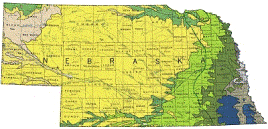US Geological Survey
Date of this Version
2013
Citation
Published in Journal of Geophysical Research: Atmospheres (2013) 118: 5065-5081. DOI:10.1002/jgrd.50387
Abstract
A new model coupling scheme with remote sensing data assimilation was developed for estimation of daily actual evapotranspiration (ET). The scheme consists of the VegET, a model to estimate ET from meteorological and water balance data, and an Event Driven Phenology Model (EDPM), an empirical crop specific model trained on multiple years of flux tower data transformed into six types of environmental forcings that are called “events” to emphasize their temporally discrete character, which has advantages for modeling multiple contingent influences. The EDPM in prognostic mode supplies seasonal trajectories of normalized difference vegetation index (NDVI); whereas in diagnostic mode, it can adjust the NDVI prediction with assimilated remotely sensed observations. The scheme was deployed within the croplands of the Northern Great Plains. The evaluation used 2007–2009 land surface forcing data from the North American Land Data Assimilation System and crop maps derived from remotely sensed data of NASA’s Moderate Resolution Imaging Spectroradiometer (MODIS). We compared the NDVI produced by the EDPM with NDVI data derived from the MODIS nadir bidirectional reflectance distribution function adjusted reflectance product. The EDPM performance in prognostic mode yielded a coefficient of determination (r2) of 0.8±0.15and the root mean square error (RMSE) of 0.1±0.035 across the entire study area. Retrospective correction of canopy attributes using assimilated MODIS NDVI values improved EDPMNDVI estimates, bringing the errors down to the average level of 0.1. The ET estimates produced by the coupled scheme were compared with the MODIS evapotranspiration product and with ET from NASA’s Mosaic land surface model. The expected r2=0.7±0.15 and RMSE = 11.2±4mm per 8 days achieved in earlier point-based validations were met in this study by the coupling scheme functioning in both prognostic and retrospective modes. Coupled model performance was diminished at the periphery of the study area where r2 values were about 0.5 and RMSEs up to 15±5mm per 8 days. This performance degradation can be attributed both to insufficient EDPM training and to spatial heterogeneity in the accuracy of the crop maps. Overall, the experiment provided sufficient evidence of soundness of the EDPM and VegET coupling scheme, assuring its potential for spatially explicit applications.

